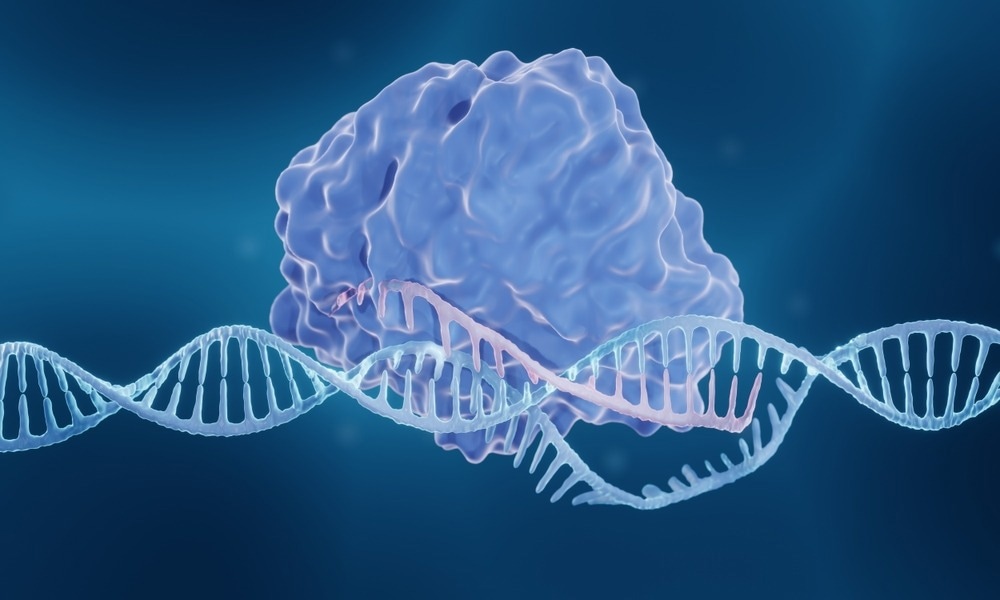In a recent study published in Cell Reports, researchers demonstrated clustered regularly interspersed short palindromic repeats (CRISPR)-mediated elimination of glioblastoma (GBM) cells.
 Study: Targeting the non-coding genome and temozolomide signature enables CRISPR-mediated glioma oncolysis. Image Credit: ART-ur/Shutterstock.com
Study: Targeting the non-coding genome and temozolomide signature enables CRISPR-mediated glioma oncolysis. Image Credit: ART-ur/Shutterstock.com
Background
Primary GBM is an aggressive tumor that is challenging to treat. The median survival is 12 to 15 months despite multimodal treatment regimens. Studies have indicated extensive intra-tumoral heterogeneity, with subpopulations of cells exhibiting distinct gene expression patterns, mutations, epigenetic states, and copy number aberrations, which also renders treatments targeting specific molecular processes ineffective.
Temozolomide (TMZ) is the current frontline chemotherapy for GBM, and sensitivity to TMZ is determined by the methylation of the O-6-methylguanine-DNA methyltransferase (MGMT) promoter. Although TMZ-based treatments improve survival and have fewer side effects, most patients experience disease progression.
TMZ also increases the somatic mutation rate and coupled with the loss of DNA mismatch repair (MMR) pathways and tumor genomic instability, it leads to hypermutation. Currently, there is no effective treatment for hypermutated gliomas. Thus, therapies that eliminate GBM cells, regardless of their mutational profile, are urgently needed.
The study and findings
In the present study, researchers introduced genome/cancer shedding, a CRISPR-based therapeutic strategy to treat primary/recurrent GBM by targeting unique repeat sequences in tumor genomes. First, they compared the primary and recurrent GBMs of a patient to their native genome. The patient underwent surgical resection, adjuvant radiotherapy, and TMZ chemotherapy and had a relapse after 11 months.
Quantification of tumor mutational burden revealed a median of 123 and 217 mutations per megabase for the primary and recurrent GBM, respectively, classifying both as hypermutated. There were over 4,400 and 11,600 protein-coding mutations and 451,484 and 698,557 mutations in the non-coding genome in the primary and recurrent GBM, respectively.
The researchers computed possible Streptococcus pyogenes CRISPR-associated 9 (Cas9) single-guide RNAs (sgRNAs) in the patient’s native genome and the primary and recurrent GBM. There were hundreds of millions of sgRNAs possible in this target space, termed the “sgRNA-ome,” a large proportion of which had multiple target loci. The team referred to these sgRNAs with repetitive target loci as sgCIDEs (for CRISPR-induced death by editing).
Next, they selected the top 10 sgCIDEs, featuring between 3000 and 300,000 target sites, to assess the ability of CRISPR-Cas9 to eliminate GBM by targeting repetitive sequences. Stable expression of Cas9 and the 10 sgCIDEs in LN-229 and U-251 GBM cells caused robust and rapid cell depletion, whereas those expressing non-targeting sgRNAs did not deplete.
Cells expressing Cas9 showed extensive genome fragmentation 24 hours after transduction with sgCIDEs. Further, real-time quantitative live-cell imaging indicated that sgCIDEs caused growth inhibition on day 1 after transduction and cell death by day 2. Next, the team tested genome shredding in TMZ-sensitive and -resistant GBMs.
Cas9-expressing TMZ-resistant LN-18 and T98G and TMZ-sensitive LN-229 and U-251 GBM cells were treated with TMZ or transduced with sgCIDE-containing lentiviral vectors. Cell viability quantification revealed anticipated effects for TMZ dose titrations, with lethality evident only in TMZ-sensitive cells. By contrast, the expression of sgCIDEs caused viral titer-dependent lethality in all four cell lines, independent of the methylation status of the MGMT promoter.
Colony formation assays revealed a one- to two-log-scale reduction in colonies in TMZ-treated U-251 cells relative to dimethyl sulfoxide (DMSO)-treated cells, whereas a two- to three-log-scale reduction in colonies was observed with sgCIDE transduction. Nevertheless, some sgCIDE-transduced cells survived and formed colonies.
Monoclonal cell lines of these escapee clones were established, and lentiviral vectors expressing sgRNA and mCherry or an all-in-one version encoding sgRNA and mCherry-tagged Cas9 were developed. Re-treating escapee clones with vectors providing only a new sgRNA failed to cause cell depletion, whereas re-treatment with the all-in-one vector led to efficient cell ablation.
Additional investigations suggested that the minimum number of DSBs required to eliminate a cell efficiently was 30 for fully complementary target sites and 70 for those with a single mismatch. As the targets for genome shredding also exist in normal genomes, the researchers speculated that cancer-specific mutations in hypermutated gliomas may have unique sequences that can be leveraged for cancer-specific genome shredding (cancer shredding).
The recurrent GBM showed the characteristic TMZ mutational signature (elevated cytosine-to-thymine conversions) of the hypermutated GBM. Next, the team used a recurrent GBM-derived cell line to assess whether the TMZ mutational signature could be exploited for specific targeting and cell ablation. This patient-derived cell line (PDCL), named SF11411, had a similar sensitivity to genome shredding as other GBM cell lines.
The researchers identified 10 sgRNAs that were repetitive and unique to the recurrent tumor. For validation, the team performed a large-scale CRISPR screen in normal human astrocytes (NHAs) and PDCL SF11411. The CRISPR library encompassed (around 5000) guides targeting non-coding and coding genome at a single locus or multiple loci, sgCIDEs, non-targeting controls, and safe-harbor references.
Next-generation sequencing was used to compare NHAs, and PDCL cells were transduced at a single copy with the CRISPR library on days 1 and 28 after transduction. As expected, most sgCIDEs were depleted in both cell lines. Non-targeting controls had neutral effects in both cell lines, whereas cancer-specific repetitive sgRNAs were depleted only in SF11411 but enriched in NHAs.
Conclusions
Taken together, the study described CRISPR-mediated genome/cancer shredding to treat recurrent gliomas. Cancer shredding relies on targeting repetitive tumor-specific loci, triggering CRISPR-mediated fragmentation of the genome and DNA damage-induced cell death. Further, genome shredding was independent of TMZ sensitivity and the epigenetic status of GBM cells.
Most cells succumb to the initial DNA damage, and rare escapees can be efficiently re-treated. The presence of tumor-specific repeats enables cancer shredding by targeting the therapy-induced mutational signature. Overall, the findings present a potential avenue for developing cancer-specific therapies to treat hypermutated gliomas and other hypermutated cancers.